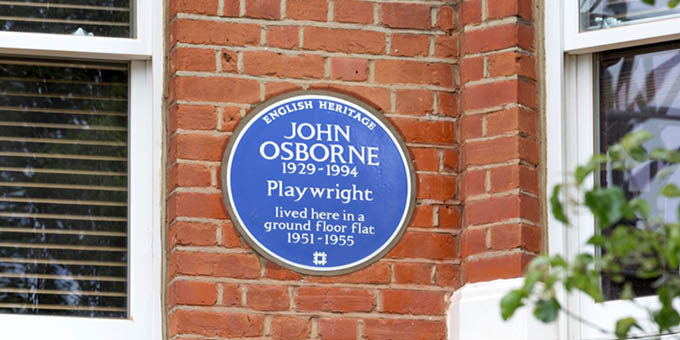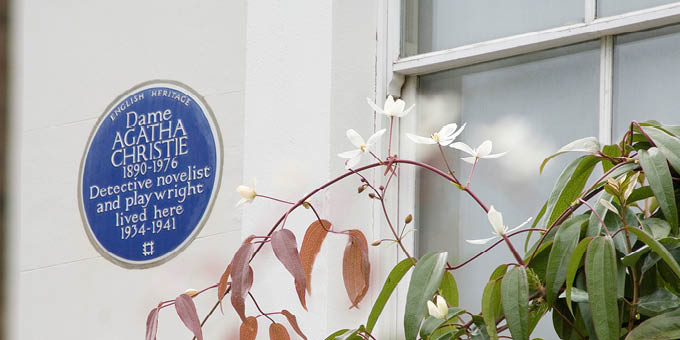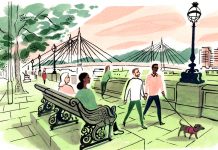Blue Plaques offer a magical connection to famous London residents, writes Sarah Londsale
“I looked out of the window and people were standing at the front gate, pointing up at me and taking pictures, and I wondered how I had suddenly become famous,” says Philippe Scholl. “Then I realised that they weren’t looking at me, but at the English Heritage Blue Plaque to our home’s former resident that had just been put up.”
Philippe Scholl and Benedicte Pfister live in a tall, handsome red brick house just off Brook Green, Hammersmith. It’s a smart address now but back in the 1950s in grim austerity Britain, a struggling young actor sat in the damp ground floor flat at 53, Caithness Road, trying to write a play that would express his misery. The play about the disenchanted post-war generation, Look Back in Anger, was instantly recognised as a revolutionary new voice and made the young John Osborne an overnight star.
When the couple bought number 53, now converted into a single house, eight years ago, they had no idea of its former famous occupant. “We only found out in April 2018, when English Heritage wrote to us asking us if we would be happy for the plaque to be installed,” says Pfister. “Discovering about our home’s past was a magical thing,” she says. “You feel more connected, and you realise that it has a life before, and after you, that you are its custodian. The Plaque itself is also a beautiful thing.”

Celebrity connection
Timothy Clifton-Wright, who lives in a flat adorned with a Blue Plaque, feels a connection both to his home’s former occupant, and to the wider Bloomsbury area, steeped in London’s history. The data scientist bought the flat before he learned in 2020 that he was living in the former home of Dame Helen Gwynne-Vaughan (1879-1967), a botanist and leader of the first women’s army corps during the First World War. Bedford Court Mansions, built in the 1890s had been her home for 50 years. The connections are eerie: like Gwynne-Vaughan, Clifton-Wright studied science at King’s College, London. And also like her, he loves plants: various species of monstera, pothos, philodendra, dragon plants and peace lilies adorn the red brick flat. “When I found out about Gwynne- Vaughan, I named my newest plant in her honour: Helen the Hoya,” he says.
What do Blue Plaques mean?
Across London there are nearly 1,000 official English Heritage commemorative plaques, with 12 new ones installed every year. The scheme began in 1866, originally by the Royal Society of Arts, and commemorates artistic, scientific, political and royal celebrities ranging from writer George Orwell in Camden, the Chelsea house where Bob Marley wrote some of his best-loved songs including ‘Three Little Birds’, and the crime writer Agatha Christie’s home in Holland Park where she wrote her bestseller Death on the Nile, the latest film adaptation of which is currently showing in London’s cinemas. This year’s list includes Fanny Wilkinson, Britain’s first professional female landscape gardener, who lived in Bloomsbury, and the philosopher Isaiah Berlin, who lived in Holland Park.
English Heritage senior historian Howard Spencer says the plaques “remind people that a building is more than the sum total of the bricks and mortar, it’s also about all the people who lived in it”. He says all homeowners are asked for permission before a plaque is erected. “Very occasionally people say no but normally they are thrilled.”
How to find out about the history of your home
- Digitised census records, and London Electoral Registers online via services such as co.uk. These sites usually offer a 14-day free trial and then charge between £10.99 and £19.99 a month.
- Local London borough libraries hold old rate books which have a wealth of information on households.
- Local churches will hold records of marriages, baptisms and funerals; cemetery headstones will also yield information.
- The British Library holds digitised and easily searchable records of hundreds of local newspapers; it is free to obtain a reader’s pass.
- A free digitised and searchable edition of the first Ordnance Survey maps dating back to the 1840s and covering the whole of London is available through the National Library of Scotland
- You can propose a plaque to English Heritage. This is a lengthy process and can take up to three years.
Read more from The London Hub:
- How the city’s street signs unlock a place and time in London history
- Swinging London: Chelsea residents remember the King’s Road in the 60s
- Finding Neverland: The London home that inspired JM Barrie to write Peter Pan is for sale
Follow The London Magazine on Instagram to stay up to date with recent features and exciting announcements. For more London stories, click through to our London hub here






 © 2024
© 2024